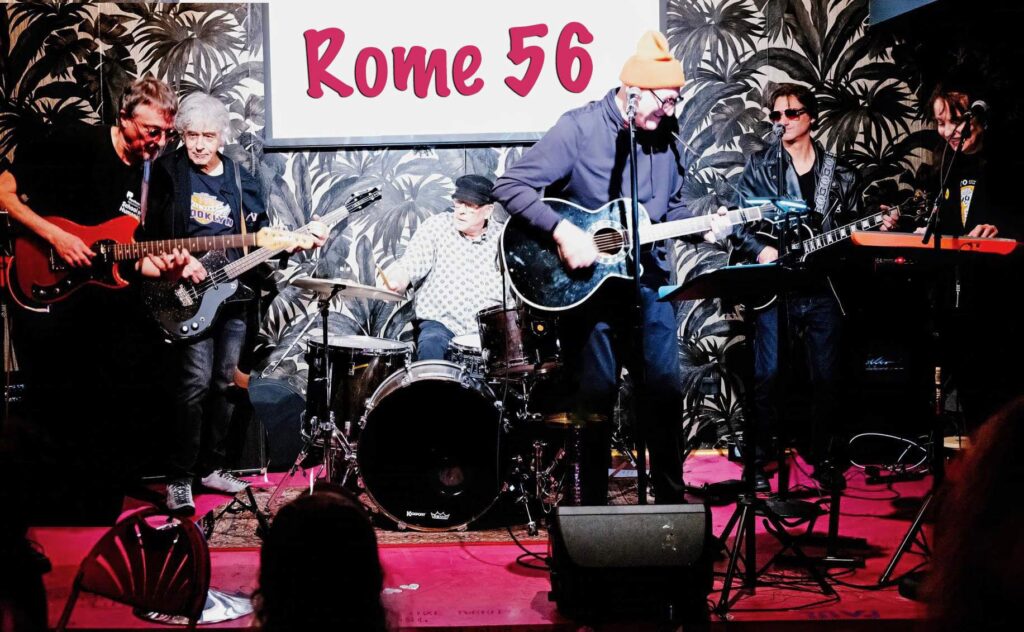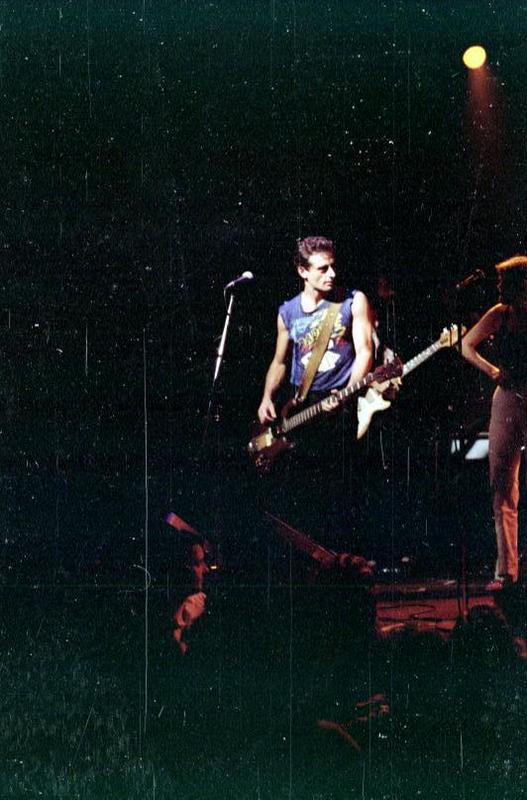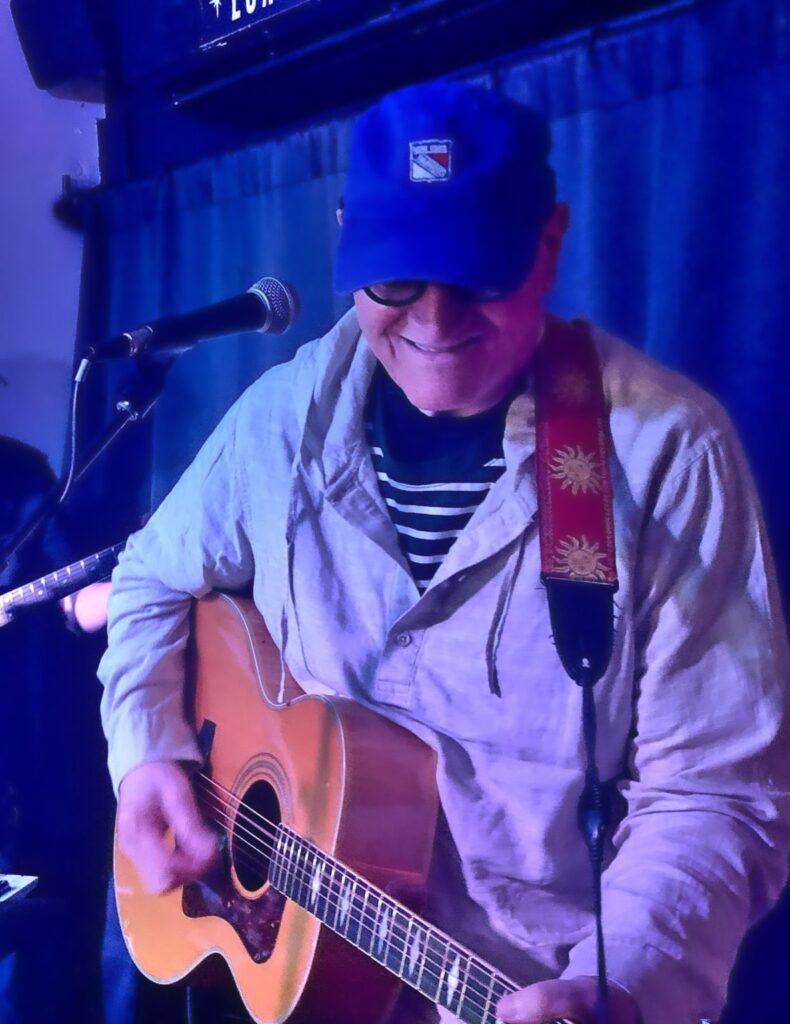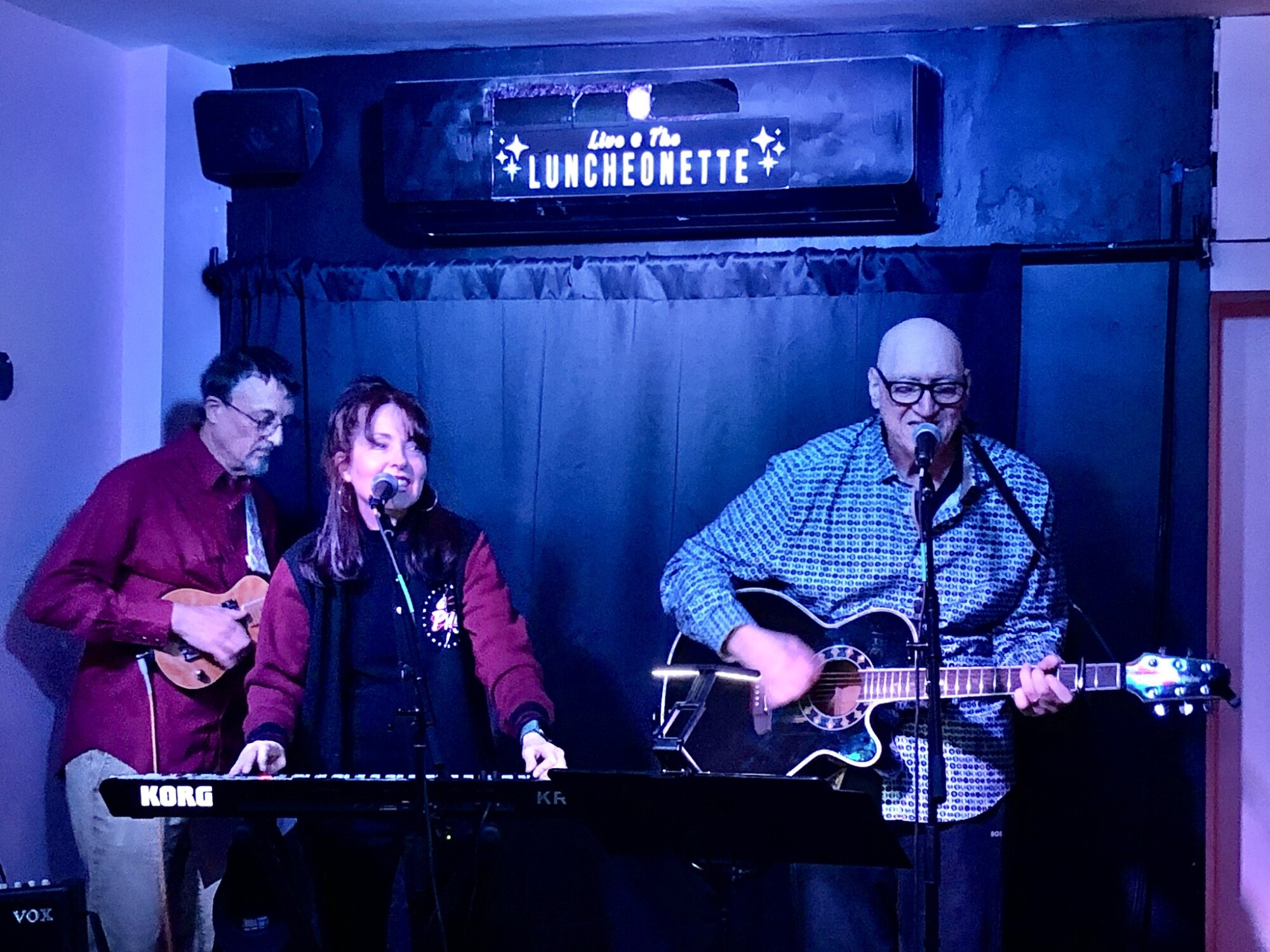Rome 56 | Interview | New Album, ‘Paradise Is Free’
Rome 56 is a band that’s been churning out raw, electrifying sounds that blur the lines between classic melody and unfiltered rock ‘n’ roll.
Their latest album, ‘Paradise Is Free,’ is a sonic tapestry woven from threads of acoustic folk and Beatles-esque flair, proving they’re not just riding the coattails of past greatness but carving out their own gritty niche. Their creative spark ignites in the clash of New York’s mundane grind and Amsterdam’s vibrant, transient energy, where their studio sessions are as unpredictable as a midnight street fight.

“With Rome 56, I was able to develop more of my own sound”
How did your background with The Shirts influence the sound and direction of Rome 56’s latest album, Paradise Is Free?
Arthur Lamonica: Most of the things I learned in music happened while I was with The Shirts. The Shirts had a diverse approach to sound, and personally, I always leaned towards melody—writing songs like ‘Tell Me Your Plans.’ I grew up musically with The Shirts, but with Rome 56, I was able to develop more of my own sound—introducing more acoustic guitar and folk-pop rock. As a model for my songwriting and recording, I went towards The Beatles, using the ‘Help!’ album as a basic template—bringing in acoustic guitar along with piano, bass, and drums.
Could you elaborate on the creative process behind recording ‘Paradise Is Free’ between New York and Amsterdam? How did the different locations impact the album’s atmosphere and sonic palette?
There’s not a lot of difference between the NY and the Dutch band. All the songs are always demoed by me at home. Our last CD was done mostly during lockdown, so for ‘Paradise Is Free,’ I wanted to achieve a more live recording sound—hence booking some recording sessions in Amsterdam. Since we’re only in The Netherlands for a short time, the band is well prepared for the live shows we do there. I send the songs in advance, and then we go into some intense full-day rehearsals. So, the studio recordings came together quickly, picking the best tunes. In NY, it was more piecemeal—I laid down demos and recorded parts according to the band’s availability. Given our short stays in Amsterdam, there is a concerted effort to do things together, and the few songs that were not complete we were able to finish up via some new technology using a remote shared studio (us in NY and the band in Amsterdam).
‘Man Behind the Man With a Gun’ sets an intriguing tone for the album. What inspired the ambiguity in its lyrics, and how does it tie into the overall theme or message of the record?
I wanted it to be more like a Western—I kind of got it from the movie Pat Garrett and Billy The Kid. The title might invoke thoughts of current affairs, but this was more of a take on a Western. The concept of the man behind the gun is interesting—because when you think about it, that’s where all the wars start, etc. Gun violence isn’t only just random—there’s a ‘Man Behind the Man With a Gun.’ So I took that concept, and putting it through the lens of a Western gave me a direction.
‘Hustle of the Crowd’ and ‘Invisible Man’ demonstrate a range of musical styles within the album. Could you discuss the inspiration behind these tracks and how they contribute to the album’s thematic narrative?
These two songs were, somewhat, on different ends of the spectrum. ‘Invisible Man’ was definitely a NY song worked out with the band—we spent a lot of time on the arrangement together, and I was very pleased with it in the end. The catchphrase “you gotta go home” came from the thought you have when you realize you’re out late at night and you don’t have a car but you gotta catch that last train or bus. ‘Hustle of the Crowd’ went down easier. The inspiration came partly from looking down from a rooftop—watching a crowd from afar. I got the riff on the guitar using a capo and some different inversions—so off that I laid down the drum track, and Kathy put on some keyboard and vocals. ‘Hustle of the Crowd’ was something new and fresh—it was a rather spontaneous development. Whereas Invisible Man was more worked out.
What is it like to work together? What unique dynamic do you think you bring to Rome 56’s creative process?
The dynamic always changes—the NY band has a certain dynamic, and with the Dutch, it’s different. It’s always exciting in The Netherlands because we’re away, and the people we meet and friendships we’ve made are special. There’s always a lighter feel away. In NY, you’re home, so there’s always a sense of the mundane because you’re thinking about the laundry, etc. Being in Europe is like being on vacation, even with the gigs and all. The NY band has other schedules too because we all have our outside lives, but when we get together, it’s great.
‘Paradise Is Free’ adds another chapter to Rome 56’s enduring songbook. How does this album fit into the band’s evolution, and what aspects of their musical identity does it reinforce or redefine?
There are always way more songs than go on the record. So I start off with 20-30 songs—some more complete than others. And then it comes down to the basic model of 12 songs. It’s a continuation of the guide I have been using for the last 4 records—it’s very acoustic guitar driven, and we try to use conventional keyboards—piano, organ, and maybe some synthesizer—trying to have as much color as possible.
Would you like to share about your upbringing? Where did you all grow up? Tell us about daily life back in your teenage years.
Three of The Shirts lived within 6 blocks of each other, and we knew each other from grammar school. The other members of The Shirts were in Brooklyn too— a little further away but basically from the same area. I was raised by my mother—my father passed away when I was young, and my sisters were a bit older and moved out early, so I pretty much had a solitary home existence. But I had a lot of friends, and we would play ball outside—it was a very urban environment—playing in the streets. I grew up in a tenement apartment above a bar called The Ritz Bar & Grill, and I would literally go to sleep listening to the jukebox play 1950s music like Little Anthony and The Imperials, The Drifters, and The Flamingos, whose song ‘I Only Have Eyes for You’ I heard almost nightly against the din of the constant bar noise. Then The Beatles came when I was 12 years old, and that was a very big deal for me. That was when I started to think about music and enjoy music—that’s what changed me and my thinking towards music. I begged my mother to buy me a guitar, so we bought a $25 Spanish guitar from the local music store. And then I would practice in my room—I was self-taught.
Was there a certain scene you were part of? Maybe you had some favorite hangout places? Did you attend a lot of gigs back then?
The only scene I was part of was the CBGB scene starting in 1974. But before that, we used to go to a lot of shows at the Fillmore East. So, I got to see all the amazing bands—the Jimi Hendrix Experience, Jefferson Airplane… so many. I’d have to make a list of how many great shows I saw there—that was a great time. We weren’t really doing the bar scene. Once the CBGB scene started, we were like the Brooklyn band—we practically lived there from 1974-1982. So that was pretty much the scene that we were part of—we were kind of on the fringe—not really “in” with the famous ones—but we were there—we were contemporaries.
Can you elaborate on the formation of The Shirts? What inspired the formation of The Shirts as a band, and how did their early influences shape their sound and style?
At first, through Bob Racioppo, I was in an original band called Lackeys and Schemers. Then the other guitar player wound up going to Italy for medical school, so we just disbanded. At that time, I was living in Long Island, and I was coming in on weekends to play music. So Bob and I decided to put together another band with his cousin Ron Ardito. Then I met Annie at a bar in Brooklyn, and we were singing to Rolling Stones songs on the jukebox, and I said, “I’ve got a band—you should sing in our band.” And she came down, and that was the beginning of The Shirts.
How did you get signed to Capitol, and what led to the recording of your debut album in 1978?
We were playing CBGB’s and had a gig with Deaf School, and Nick Mobbs, who was then the head of A&R for EMI, came down to see Deaf School and saw us. He just fell in love with us. He said the thing that really intrigued him was the turnaround (the skip up) in ‘Tell Me Your Plans.’ He sent a telegram to Hilly and said, “I must sign The Shirts from Brooklyn.” So then we were looking for producers. At first, the Shulman Brothers from Gentle Giant were interested in producing us. Then we met Tony Bongiovi. Then they sent Mike Thorne over from London, and he came and hung out at The Shirts’ house. We just thought he was kind of an odd-looking fellow. He had a pink mohair sweater and seemed like an interesting guy—and he just kept talking and hung out—he didn’t leave. And we thought—wow. And then he said we’d record in London, and I said, “That’s it”—as far as I was concerned, that was a done deal!

What are some of the strongest memories from working on those songs for the debut album?
Well, we recorded in London, which was great! It was very regimented. Mike Thorne had an almost militaristic way of recording—changing strings pretty regularly and driving us hard while doing the basic tracks. But it was enjoyable because we did a tour of London studios. We did the basic tracks at Wessex Studios, noted for the platform where Queen did the stomping in ‘We Will Rock You,’ and it was an old church converted into a studio—so that was great. Then we went to Eden Studios, which is where Elvis Costello recorded. It was in a very out-of-the-way part of London, had an unassuming look, and a homemade mixing board—not like the big giant mixing boards. And then we went to Abbey Road and did one day there, which was, of course, fantastic just to be there. We wandered into Studio Two, looking for any signs of Beatlemania!
What about the other two albums that followed? How do you recall them?
After the first, we did ‘Street Light Shine.’ Mike (Thorne) had come to NY and thought it would be fun to do something in NY. It wasn’t as much fun for the band because we were at home—it’s much more exciting when you’re away. We were just getting in the car and driving to midtown as opposed to being in a foreign city—but it was a good experience and probably a more costly venture because NY is always more expensive. The last record was done in the Capitol Tower, and there was a team set up for us by Capitol and A&R Bobby Colomby (Blood, Sweat & Tears) to do it there. It was very different—we recorded the tracks live again, and it was good. And just being in that building with all its musical history (Sinatra and the like) was a great experience.
You did many amazing gigs. What would be the craziest one? What about the most memorable?
The Marquee Club was really amazing because of its history. It was our first tour, and here we were playing in the club where every great band performed—Jimi Hendrix, The Who… On our second tour, we played a crazy outdoor festival in Lagos, Portugal, where the electricity went out 3 times, and it was very hot and really crowded. Just getting to the stage was chaos—it was almost impossible to drive through the crowd. And, of course, there was the Peter Gabriel tour, which was the most fun. He even took us on a side trip to the Alps.
The Shirts’ lyrics often explore themes of urban life, relationships, and societal issues. How were these messages received by audiences?
Although we were portrayed as a very Brooklyn street band, we did explore some cerebral concepts in our lyrics, and our audience went with it. When we played “Poe” in Boston, some of the students from Harvard would bring paperbacks of Edgar Allan Poe and rip out pages during the show. They’d get very excited.
CBGB played a pivotal role in shaping the punk rock scene in the 1970s. Can you discuss the significance of CBGB as a cultural hub for emerging artists and bands, and how did its influence extend beyond the music industry?
Absolutely! CBGB was THE place for original bands to play. First, the bands went there, then the local press, then the record companies. It became the hotbed place for at least 5 years. It was the most important club in the city—that became THE scene, and people were starting to come from all over the country, all over the world—it was a destination place for bands to come to and try and get to play there. It was that important.
Let’s end this interview with some of your favorite albums. Have you found something new lately that you would like to recommend to our readers?
‘Hallucinate’ by Bees Deluxe—it’s more than a blues album. Conrad Warre’s songs are original and witty. These albums come to mind today, but tomorrow could well be another group—too many to mention:
‘Hunky Dory’ … David Bowie
‘Court and Spark’ … Joni Mitchell
‘Twin Cinema’ … New Pornographers
’10, 9, 8, 7, 6′ … Midnight Oil
‘Another Green World’ … Eno
‘Child Is the Father to the Man’ … BS&T
’10 Mistakes’ … Gruppo Sportivo
‘Oh Mercy’ … Bob Dylan

Thank you. The last word is yours.
When in despair, pick up a guitar—and please stop all these endless wars.
Klemen Breznikar
Headline photo: Rome 56 | Photo by Anne Husick
Rome 56 Official Website / Facebook / Twitter / Bandcamp
Think Like A Key Music Official Website / Facebook / Twitter / Instagram / Bandcamp / YouTube
The Shirts | Interview | CBGB Legends Reborn




